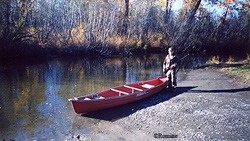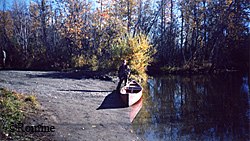Alaska Fish & Wildlife News
October 2007
A Moose Hunt Adventure

During a hunting discussion a few seasons ago one of the guys said, “Just go out to the Palmer Hay Flats, get up in a tree and you might get lucky enough to have a spike/fork run by, scared by other hunters.” My friend Dave was home from fishing in the Bering Sea and I asked him if he’d like to try the Flats for a moose. We decided it just might work. On the appointed day we loaded my canoe in the back of the pick-up and we were off.
We put in at Rabbit Slough, also known as Wasilla Creek, off the Glenn Highway at the access road. The air was a cool 40 degrees and we were excited to get going. The slough is about 35 feet across at this point with a steady but calm current running out to Knik Arm. This area is forested and felt closed in. We noticed a few silvers still in the slough. Paddling required very little effort as we were moving with the current.
We quietly paddled in the cool morning air, passing through trees and brush that lined the edges with an occasional cottonwood big enough to climb. The float was too enjoyable to consider stopping so soon. Slowly the trees started opening up to clearings and we caught glimpses of the hay flats.
Gradually we noticed that the current was turning against us. The tide was changing. We now had to bend into the current to keep going. We decided to stop for a sandwich at a floating platform used by duck hunters and wait for the tide to turn. We had planned on spending a week so we were in no hurry. Gradually the tide cycled and we pushed off again. Continuing on our lazy journey we passed through large open areas and saw a few duck hunters in the distance. The sun was brightly shining down and we were mesmerized by the easy float with the current.
We passed through an area where the banks were high and muddy. The trees were long gone by now and we should have turned around. As we approached the inlet we were on a vast mud flat with not a single piece of vegetation. The water kept getting shallower and shallower but was still carrying us along.
Suddenly we came to a complete stop having grounded the canoe on the mud. (Later I looked on a map and was able to find where we were at this time. It was Coffee Point.) Not to worry, we would simply wait for the tide to turn again and we’d head back to the trees. So we broke out the cold fried chicken and canteens. We could plainly hear the traffic on the Glenn Highway. The hours went by. At first we were hesitant to get out of the canoe on the mud but eventually tried it. It offered a chance to stretch our legs while we were waiting.
The only real sound was the traffic on the Glenn everything else was quiet when I heard a kind of roaring sound. I looked out toward the inlet. Then I heard Dave say, “I’ve read about it but I have never seen one. That’s a bore tide.” A wall of water about eighteen inches high was rapidly approaching us. After a moment’s hesitation I said we better get back in the canoe. We jumped in and braced ourselves for the hit. It wasn’t long in coming. When the water hit us it immediately lifted us and threw us backward and around the point of land toward the Knik River. Not the way we came. Dave and I both have lots of experience with canoes and were able to dig deep into the water with the paddles and turn us so we were going back up Wasilla Creek/Rabbit Slough.

We rounded the point and were heading the way we came, swept along at a furious pace riding on the tide. At one point the bow of the canoe was actually riding the front edge of the tide like a surf board. We could see the bare mud in front of the canoe. What had started just a few minutes ago as terrifying experience now became fun. We were zipping along. The fun only lasted a short time when we came to the first big bend in the creek. We were now back at the high mud wall of the creek and a sharp bend to the left was coming up. We certainly were not in control of our speed or direction so all we could do was to hold on.
When we hit the turn the current threw us sideways. Now we were going at that same high speed again - only sideways. I still had my paddle in my hand and I tried to dig at the mud on my left side to try to slow us down. As soon as my paddle came in contact with the mud it went under the boat. By some miracle I was able to intercept it with my right hand as it came under the canoe.
As the water spread out and the leading edge got further upstream we were able to regain control of the canoe. In all this time we had not said a word. Now we began to take stock of our situation. High mud walls rose up beside us on both banks and it was starting to get late in the day. We decided to look for a place to put in and spend the night. There were some tributaries coming into the creek as deep gouges in the banks. We turned into one of these and canoed as far as we thought would be necessary to escape the influence of the creek and the tides. The gouge or cut we were in was filling up with water so we were actually going up as we traveled further up the tributary. We got a good distance from the creek and put in to shore. I started putting up the tent and Dave scrounged around for firewood. We got a fire going and were still marveling how we had escaped that one. It was getting dark and the fire was warm.
I started to notice that the ground under my feet was getting squishy. Then we noticed the fire had started a hissing sound and looked like it was going down. A few minutes more and we knew the truth. The water was coming up over the banks of the gut we had come up. We hastily grabbed everything and threw it in the canoe. The tent came down in a flash being snatched from about an inch of water. We got into the canoe and just sat there in unbelief. The wind had picked up and was coming off the Knik glacier.
We could still hear the traffic on the Glenn Highway and now we could see their headlights. On the other side we could see the lights of Wasilla and Dave made the comment that we could die right here in the middle of everything and everybody.
We spent the rest of the night huddled against the cold in the bottom of the canoe with about four inches of water lapping at the sides. We had the fear of the canoe floating off in the dark with us in it.
After a sleepless night we left at first light and canoed back to where we had put in only the day before. Bed and a hot shower was all we had in mind. To this day we still recall the adventure to each other and wonder how we made it out of the Palmer Hay Flats.
Mike Romine is a Fish and Wildlife Technician II with the Sport Fish Division in Anchorage. He owns four canoes and has enjoyed many less-harrowing moose hunts.
Subscribe to be notified about new issues
Receive a monthly notice about new issues and articles.
